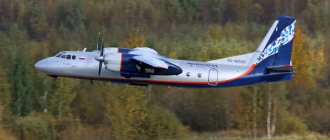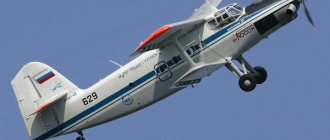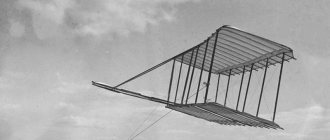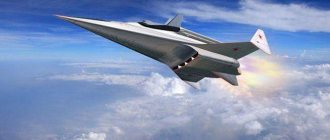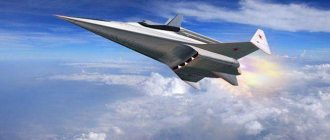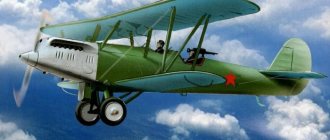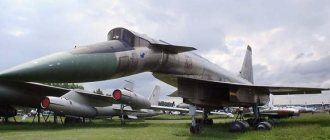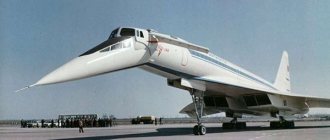Speaking about OKB aircraft. Sukhoi, we usually imagine formidable combat vehicles, like the Su-25 attack aircraft or the Su-27 fighter. However, the specialists of this design bureau created several excellent sports aerobatic aircraft, the first of which was the Su-26.
Its further development can be called the two-seater Su-29 aircraft, which is intended for training and training pilots, as well as participation in various air shows and flight skills competitions.
The first takeoff of the Su-29 aircraft took place at the end of 1991, and the next year mass production of the aircraft began.
To date, about 60 aircraft have been manufactured. They are actively used, not only in Russia, but also abroad: in South Africa, the USA, Australia and the UK. In the late 90s, seven Su-29 aircraft were purchased by the Argentine Air Force. True, these Su-29s were very different from the basic modification of the aircraft. They were equipped with Western avionics, a new canopy, landing gear and propeller.
The main operator of the Su-29 in Russia is DOSAAF.
Su-29 Engine. Dimensions. Range of flight. Practical ceiling. Story
Work on the two-seat trainer and sports aircraft Su-29 began at the Design Bureau named after. BY. Sukhoi in 1990. It became a further development of the sports aerobatic acrobatic aircraft Su-26M. When developing the aerodynamic design and design of the Su-29 aircraft, many years of experience in operating the Su-26, as well as the wishes of sports pilots, were taken into account. The two-seat Su-29 is designed for training, preparation and participation of athletes in domestic and international aerobatics competitions. In 1991, construction began on two aircraft prototypes intended for flight tests, as well as two for statistical tests.
Military aircraft Su-57
In 2022, at the MAKS-2019 air show, the first export version of the Su-57E and other new Russian military aircraft . Many countries around the world have recognized the aircraft as attractive in terms of performance characteristics and cost.
The first full-fledged prototype appeared back in 2004. Then engineers worked on creating a 5th generation aircraft. The promising front-line aviation complex (PAK FA) T-50 was first flown into the air by test pilot S.L. Bogdan . Then he spent a little less than an hour in the air.
ON THE TOPIC - A photograph of the newest Russian military aircraft is presented
In 2022, Russian President Vladimir Putin gave instructions for the purchase of 76 fighters of this class. To date, all state tests have been successfully completed, the aircraft has entered production and is gradually entering military units of the Russian Aerospace Forces.
Characteristics (performance characteristics) of the Su-57 aircraft
It is very difficult to judge the tactical and technical characteristics of this model, since most of them are classified as classified. However, if we compare the combat system with other models, we can say that the Su-57 is slightly smaller in wingspan than its fellow Su-27, but definitely wider than its potential enemy F-22.
The power plant is a “first stage” AL41-F1 bypass turbojet engine with an afterburner and controlled thrust vector (product 117). In the winter of 2022, the PAK FA T-50 with a new engine called “Product 30” was successfully tested.
Avionics includes the most modern models of radar equipment. For example, the radar of the Su-57 aircraft has five antennas, which provide the pilot with good information data.
The very design of the airframe and its coating provides the Su-57 with low visibility to enemy radars. The fuselage has smooth shapes without right angles, and protective materials absorb electronic signals well.
In the cockpit there are two universal multifunctional indicators MFI-35. The pilot can receive additional information about the flight, air targets, etc. on the wide-angle collimation system, as well as on the helmet visor.
The new Russian military aircraft 2021 Su-57 is equipped with a 9-A1-4071K aircraft cannon with a caliber of 30 millimeters, which is a modification of the GSh-301 single-barrel aircraft cannon. This product was developed by the Instrument Design Bureau named after. Academician A.G. Shipunov" in the hero city of Tula back in the 80s of the last century.
Su-29 aircraft - video
Two cabins located in tandem are intended: the first is for the instructor pilot, the second is for the athlete. When using the aircraft in a single version, aerobatics is performed from the second cockpit. In addition to the placement of the second cabin, a characteristic feature of the Su-29 aircraft is the structural modification of the middle part of the fuselage, taken from the Su-26. The modification led to its lengthening by 400 mm and weighting by 60 kg. The wing span was also slightly increased and static stability was reduced, which provided a slight increase in maneuverability. The one-piece wing is made entirely of composite materials based on carbon and organoplastics. The vertical and horizontal tails are made of the same materials. Overall, these materials make up more than half the aircraft's weight. The truss fuselage is welded from steel pipes. The power plant consists of an M-14P engine.
On August 9, 1991, the first experimental Su-29 took off. Flight tests of the Su-29 (three aircraft took part) were completed in December 1991, which made it possible to conclude a contract at the beginning of 1992 for the supply of the first batch of 12 Su-29 aircraft to the United States. Also, several dozen aircraft were sold to other countries in Europe, Africa, America and Australia. Serial production of Su-29 aircraft began in 1993 in Moscow. Since the beginning of 2001, serial production has been transferred to a new site in Lukhovitsy. In total, more than 60 Su-29 aircraft of various modifications were produced.
Traditionally, the pilot of a sports aerobatic aircraft has only a parachute as a means of rescue. When a sports plane goes into a spin at low altitude, the situation for the pilot becomes tragic. Over the past 10 years, about 30 aerobatic pilots have died in Russian flying clubs alone. Therefore, in 1994, a prototype Su-29KS aircraft was created, equipped with an ultra-light pilot rescue system SKS-94, developed by JSC NPP Zvezda.
The serial modification of the aircraft with an ejection seat was designated Su-29M. The peculiarity of this system is that it does not have a traditional ejection seat. In the event of an accident, the headrest of the pilot's seat, in which the parachute is stowed, is fired. The headrest is made in such a way that it knocks out the glazing of the cockpit canopy, then, moving away from the aircraft, quickly inserts the parachute canopy into the air flow. Almost simultaneously, the firing mechanism is triggered, which “pulls out” the pilot by his harness. Everything happens instantly. The system provides the pilot with a safe speed and trajectory relative to the falling aircraft. The new rescue system was first tested by V. Severin, a tester from NPP Zvezda JSC.
Modifications
Su-29KS - Experienced Su-29 with SKS-94 ejection seat (1994).
Su-29M - Serial Su-29 with SKS-94 ejection seat.
Su-29AR - Modification for the Argentine Air Force.
Cases of real battles between aircraft
Su and MiG aircraft were supplied to many countries, so there are recorded cases of real battles between aircraft. The fighters clashed in the Ethiopian-Eritrean conflict. In 1998, during the rearmament of the Eritrean Air Force, they purchased 3 MiG-29 units from Belarus. In response, the Ethiopian Air Force purchased the Su-27SK (specialized export modification) from the Russian Federation. During the clash against the Mig-29, the Su-27 demonstrated great efficiency and destroyed three pieces of equipment. Ultimately, the Ethiopian side was able to establish control over the air.
The improved performance characteristics of the Su-27 gave it an advantage in real combat. However, Mig at the time of its creation had completely different goals and objectives. Just before the collapse of the USSR, 653 Mig-29 units and 326 Su-27 units were in service. The light fighter's mission was to gain air superiority through numbers and control from ground posts. It was in the USSR Air Force that the MiG-29 fully revealed its capabilities.
Performance characteristics of the Su-29
Su-29 crew
— 2 people
Su-29 engine
— 1xPD M-14P
Overall dimensions of the Su-29
— Wing span: 8.20 m — Length: 7.29 m — Height: 2.74 m — Wing area: 12, 24 m²
Weight of Su-29
— Empty weight: 735 kg — Normal take-off weight: 862 kg
Su-29 speed
— Maximum permissible speed: 450 km/h — Maximum level flight speed: 385 km/h — Maximum rate of climb: 1600 m/min
Su-29 flight range
— 1200 km
Service ceiling of the Su-29
— 4000 m
Max. operational overload: 12
Military aircraft Su-27
In the 60s of the 20th century, Americans became leaders in the arms race, namely in the development of a fourth-generation military aircraft. The new fighters were supposed to replace the then outdated Phantoms, which during the Vietnam War outperformed the Soviet MiG-21 in speed, but were useless against the more maneuverable MiGs at short distances.
The history of the creation of the Su-27 aircraft
The first sketches of the American prototype appeared on paper in 1969. Subsequently, the development was named F-15 Eagle. In 1971, in the USSR, an order was issued to begin the development of a new 4th generation fighter aircraft, which would surpass the Eagle in tactical and technical characteristics.
All leading design bureaus of the USSR are invited to work on a competitive basis. It is interesting that initially designer Pavel Sukhoi did not want to work on the new aircraft, since his design bureau was working on the Su-24 aircraft . In parallel with this, Pavel Osipovich led the development of the Su-25 attack aircraft, the T-4 missile carrier, as well as the modernization of the outdated Su-15 and Su-17. There was also an opinion that the production of a fighter with the requested characteristics was impossible, since the level of technology in the radio-electronic field was not sufficiently developed for this. Despite all this, the engineers of the Sukhoi Design Bureau began, on their own initiative, to work on the exterior of the new supersonic Su-27 .
The technical requirements for the vehicle were the flight parameters of the F-15 plus 10% to all characteristics. The aircraft had to be excellent at maneuvering, reach high speed on the march, carry heavy weapons, have a good maximum non-stop flight range, as well as a modern complex of electronic equipment.
ON THE TOPIC - Vladimir Putin at the opening of MAKS-2021 announced the great potential for the development of Russian aviation
In 1972, several meetings are held regarding the new development. Engineers from the design bureaus of Sukhoi, Mikoyan and Yakovlev took part in them. After briefings from the Yakovlev Design Bureau, it was decided not to allow him to carry out further work. In the same year, the “Mikoyanites” proposed a new concept - to design two devices at once: light and heavy class fighters. It was also planned to make their equipment more unified. This solution was supposed to minimize the costs of launching the machine into series and reduce the time spent on production. Foreign “partners” also accept the same concept. The F-16 was adopted as a light aircraft, and the F-15 as a heavy aircraft.
The new Su aircraft were designated T-10. The project in sketch form was ready already in 1975, and the first test took place in the spring of 1977. Several test models were produced between 1977 and 1979. Their flights showed that the vehicle was in a very “raw” state, and the tactical and technical characteristics did not reach the required ones. In addition, the new fighter was inferior to the American aircraft in almost all respects. In addition, the designers faced a lot of problems related to the operation of the radar system. There were two options for solving the problem: create a new project or bring the existing one to fruition. The OKB management settled on the first option.
In a short time, a new concept was developed, which was called the T-10S. In the spring of 1981, the device was lifted into the air. It had a trapezoidal wing and a completely different arrangement of power plants. The front landing gear and braking system also received a different location. Other significant modifications were also made.
In the same year, the vehicle entered production, although officially all testing activities ended in 1985. Serial production was carried out by an aircraft plant in Komsomolsk-on-Amur. Also, the official adoption of the vehicle into service with the army took place in 1990. This became possible after the final elimination of all the shortcomings.
Layout of the Su-27 supersonic aircraft
The machine has an integrated circuit. The fuselage smoothly merges into the wings, forming a single structure. In Su-27 aircraft, lift is generated not only by the wings, which have a large sweep, but also by the fuselage. This significantly increases the tactical and technical parameters at high angles of attack and supersonic speed. The fighter has a vertical “tail” with two fins, and a horizontal one – made according to an all-moving design. At the leading edge of the wing, which is equipped with flaperons and leading edges with two sections, the sweep angle reaches 42°.
Conventionally, the body of a Su jet aircraft can be divided into several parts:
- A radar system, electronic equipment, landing gear, and a canopy are mounted in the front. In the cockpit of the manned vehicle there is an ejection seat model K-36DM. In two-seat fighter models they are arranged in tandem;
- In the middle there is the main center section of the wings, which is responsible for the stability and strength of the structure, fuel compartments, the combat compartment of the main weapons, and the air brake flap. There are also two landing gear struts located here;
- In the tail there are two power plants, a set of braking parachutes and a main spar with a fuel tank.
The chassis has three support struts with one of them located at the front. This arrangement provides optimal stability during takeoff and landing. All three mechanisms are equipped with one wheel, and during flight they are retracted directly into the fuselage and into the center section.
ON THE TOPIC - Russian weapons - the latest anti-satellite, space, aircraft, tanks, drones, nuclear weapons, tests and the latest models
The engines used are two AL-31F turbofan bypass power plants with an afterburner, which allows you to move for a short time in afterburner.
The fuel system includes five tanks that total 9.4 tons of fuel. Thanks to these parameters, the device has a large combat radius, and the maximum flight range without refueling is 3,900 km.
The navigation and piloting system includes:
- inertial heading system;
- aviation transponder SO-72;
- altimeter;
- controls and information devices;
- radio frequency compass;
- navigation system "Radical";
- onboard processor "Maneuver".
The fighter's protection package consists of equipment for detecting radiation from the ground or from the air, as well as equipment for releasing interference. There is also the RLPK-27 “Sword” complex, SEI-31 display equipment, equipment for effective recognition of air or ground targets, and a fire control system. Airborne objects in the front of the vehicle can be detected at a distance of up to 100 thousand m, in the rear - up to 40 thousand m. The vehicle is capable of simultaneously targeting several targets, with the ability to attack only one of them. In parallel with the RLPK-27, the OEPS-27 electronic optical system is used. It includes a thermal direction finder and a range finder based on laser technology.
Armament of the Su-27 aircraft
The Su-27 has a 30-mm GSh-301 aircraft cannon in the front right flank. Its ammunition capacity is 150 rounds. The fighter also has various missile weapons of different classes. The aircraft has 10 mounting points for outboard equipment. The combat load is 6 thousand kg, which is quite good for this generation of fighters.
Real and combat use of the Su-27 aircraft
The first production samples of equipment began to arrive in army units in 1984. Western “partners” first started talking about the Su-27 because of an unpleasant incident over the Barents Sea. Then our fighter and a Norwegian patrol plane collided. Both vehicles did not receive significant damage and independently returned to their military airfields. Before the collapse of the USSR, the bulk of Sukhoi combat aircraft with the designation “27” were in service with the air defense forces. Also, for quite a long time this car was considered one of the best in the world, thanks to its high maneuverability. She could often be seen at the most prestigious air shows. She is capable of performing the most complex aerobatics. This fascinated spectators and foreign designers.
After the collapse of the USSR, the Su-27 became part of the main fighter aircraft of the Air Force (now the VKS) of the Russian Federation. Today, according to various estimates, there are about 400 units of these models. Based on the basic Su-27, designers created many different modifications. Naturally, they are all much more advanced than their predecessors and already belong to the 4++ generation.
Russian Su-27 fighters rarely took part in real battles. One unit was shot down during the Georgian-Abkhaz War of 1992-1993. Several pieces of equipment were used during the Operation to Force Georgia to Peace in 2008. The Ethiopian Air Force also used Su-27 aircraft during the short war with Eritrea.
ON THE TOPIC - "Hawks" are restless - an American reconnaissance aircraft intercepted a Su-30SM over the Sea of Okhotsk
In the history of the fighters of the two superpowers, the Su-27 and F-15, according to official data, there has not been a single real battle. Despite this, practice battles were held. During the exercises, the Russian vehicle showed superiority at close ranges due to better maneuverability and thrust-to-weight ratio. However, at long distances, the American avionics look more effective. This was also noticeable during the American and Indian exercises Sore India 2004. The F-15s were then defeated in most training battles. Indian pilots tried to get as close as possible to their opponents and take full advantage of the aircraft's maneuverability.
Performance characteristics (TTX) of the Su-27 aircraft
| Length | 21.9 m |
| Height | 5.9 m |
| Unloaded aircraft weight | 16.3 t |
| Standard takeoff weight | 22.5 t |
| Maximum take-off weight | 30 t |
| Power point | 2xTRDD AL-31F |
| Maximum traction without using afterburner | 2*74.53 kN |
| Maximum traction using afterburner | 2*122.58 kN |
| Maximum speed | 2.500 km/h |
| Service ceiling | 18.500 m |
| Practical range | 3,680 km |
| Primary Weapon | 30-mm aircraft gun GSh-301; 10 hardpoints, which in total can carry 6 tons of useful weapons. |
Su-29 cockpits
Argentine Air Force Su-29AR
Ejection of the first pilot from the Su-29 aircraft
Similar
An-24 Engine. Dimensions. Range of flight. Practical ceiling. Story
Tu-154 Speed. Dimensions. Weight. Capacity. Fuel consumption. Story
Yak-40 Engine. Dimensions. Capacity. Range of flight. Practical ceiling. Story
An-2 Engine. Dimensions. Story. Range of flight. Service ceiling
Tu-144 Engine. Dimensions. Range of flight. Practical ceiling. Story
IL-96 Speed. Dimensions. Capacity. Story. Load capacity
IL-62 Engine. Dimensions. Range of flight. Practical ceiling. Story
IL-18 Engine. Dimensions. Range of flight. Practical ceiling. Story
IL-14 Engine. Dimensions. Story. Range of flight. Service ceiling
An-14 Pchelka Speed. Dimensions. Weight. Capacity. Story. Load capacity
An-148 Speed. Price. Dimensions. Story. Capacity. Fuel consumption
Yak-42 Speed. Dimensions. Capacity. Fuel consumption. Story. Range of flight
Tu-114 Speed. Dimensions. Weight. Capacity. Story. Load capacity
Yak-12 Speed. Dimensions. Weight. Story. Capacity. Load capacity
An-3 Engine. Dimensions. Range of flight. Service ceiling
IL-114 Engine. Dimensions. Range of flight. Service ceiling
Yak-52 Engine. Dimensions. Range of flight. Service ceiling
Tu-334 Speed. Dimensions. Weight. Story. Capacity. Range of flight
Tu-134 Speed. Dimensions. Capacity. Fuel consumption. Story. Range of flight
IL-86 Engine. Dimensions. Range of flight. Service ceiling
Tu-204 Engine. Dimensions. Range of flight. Practical ceiling. Fuel consumption. Price
Tu-104 Engine. Dimensions. Story. Range of flight. Service ceiling
Su-29 Engine. Dimensions. Range of flight. Practical ceiling. Story
Su-31 Speed. Price. Dimensions. Story. Load capacity
Tu-124 Speed. Dimensions. Capacity. Weight. Story. Range of flight
Su-26 Engine. Dimensions. Range of flight. Service ceiling
An-10 Speed. Dimensions. Weight. Story. Capacity. Load capacity
An-140 Speed. Price. Dimensions. Capacity. Fuel consumption. Story
MiG-8 Duck Engine. Dimensions. Story. Range of flight. Service ceiling
Be-30 / Be-32K Engine. Speed. Dimensions. Range of flight. Service ceiling
An-38 Speed. Dimensions. Weight. Story. Capacity. Range of flight
Be-103 Speed. Price. Dimensions. Weight. Story. Capacity
IL-103 Engine. Dimensions. Capacity. Load capacity. Range of flight. Service ceiling
LK-1 (NIAI-1 Plywood-2) History. Dimensions. Engine. Range of flight
ANT-20 Maxim Gorky Speed. Story. Engine. Dimensions. Range of flight
Tu-110 Engine. Dimensions. Range of flight. Practical ceiling. Story
Yak-58 Speed. Dimensions. Weight. Story. Range of flight. Service ceiling
Aviatika-MAI-890 Engine. Dimensions. Speed. Range of flight. Service ceiling
Yak-50 Speed. Dimensions. Story. Range of flight. Service ceiling
Yak-55 Speed. Dimensions. Weight. Story. Range of flight. Service ceiling
IL-12 Engine. Dimensions. Story. Range of flight. Service ceiling
ANT-35 (PS-35) Engine. Dimensions. Story. Range of flight. Service ceiling
Airplane K-5 Engine. Dimensions. Story. Range of flight
KhAI-1 Engine. Dimensions. Story. Range of flight. Service ceiling
Yak-53 Dimensions. Range of flight. Weight. Service ceiling
MAI-223 Kitten Photo. Video. Characteristics. Engine
AIR-6 Engine. Dimensions. Story. Range of flight. Service ceiling
PS-89 (ZIG-1) Engine. Dimensions. Story. Range of flight. Service ceiling
SAM-5 Engine. Dimensions. Story. Range of flight. Service ceiling
Airplane Steel-3 Engine. Dimensions. Story. Range of flight
Airplane ANT-1 Engine. Dimensions. Story. Range of flight
Airplane U-8 Little Humpbacked Horse History. Dimensions. Engine
Airplane K-1 Engine. Dimensions. Story. Range of flight
